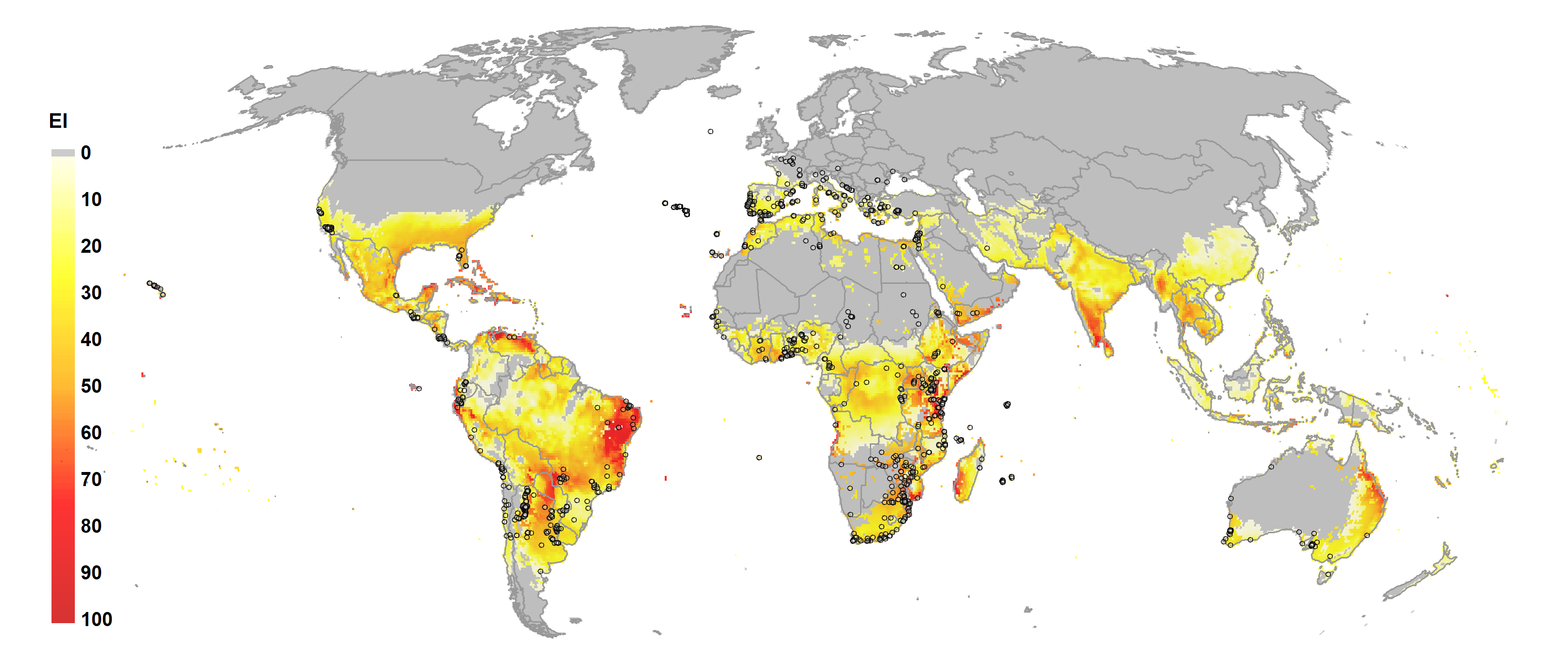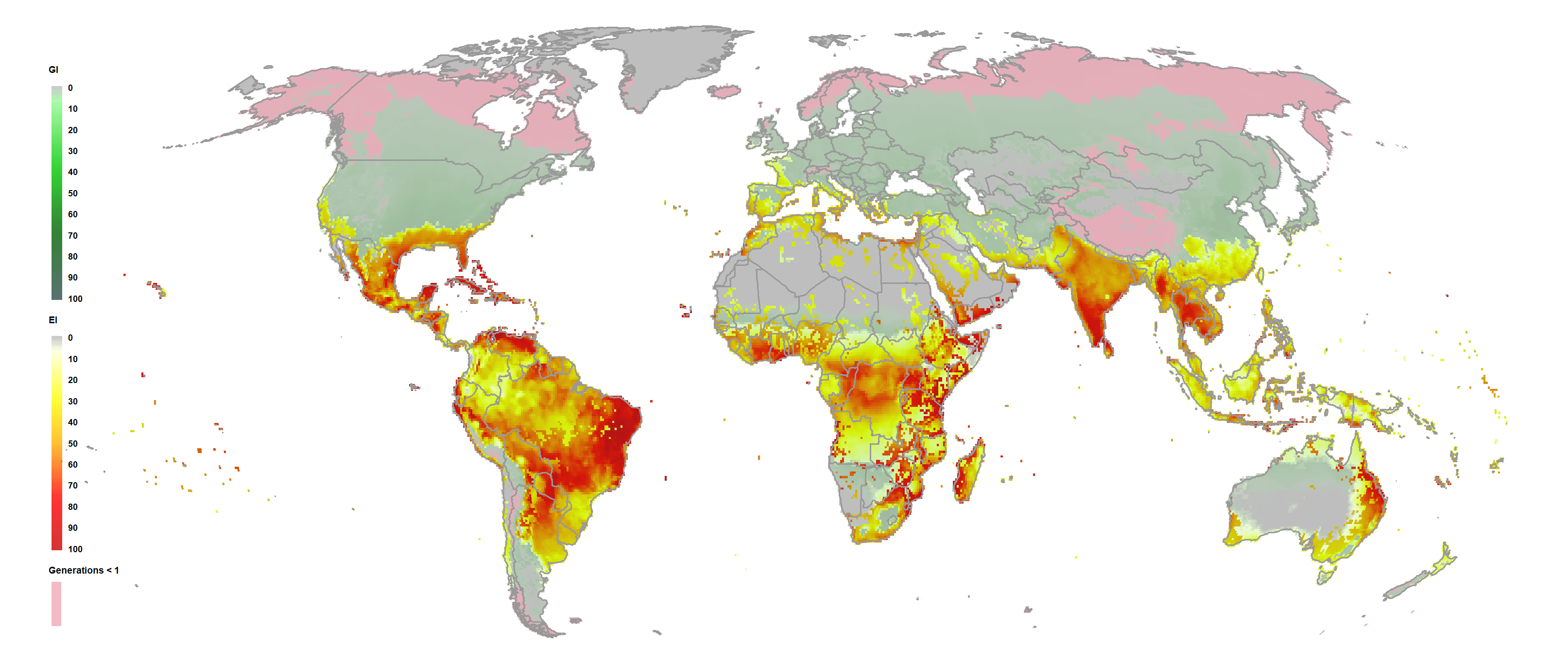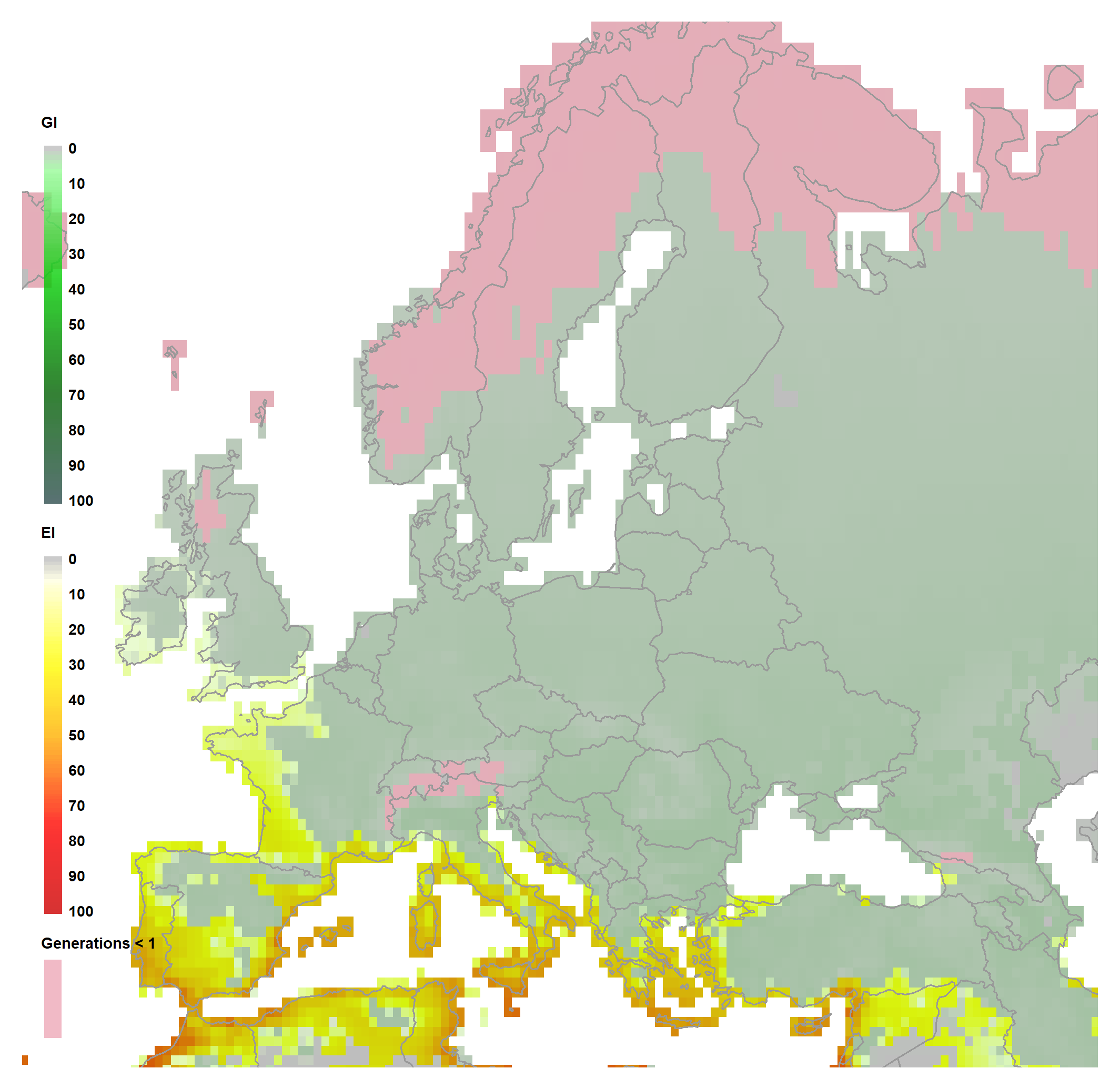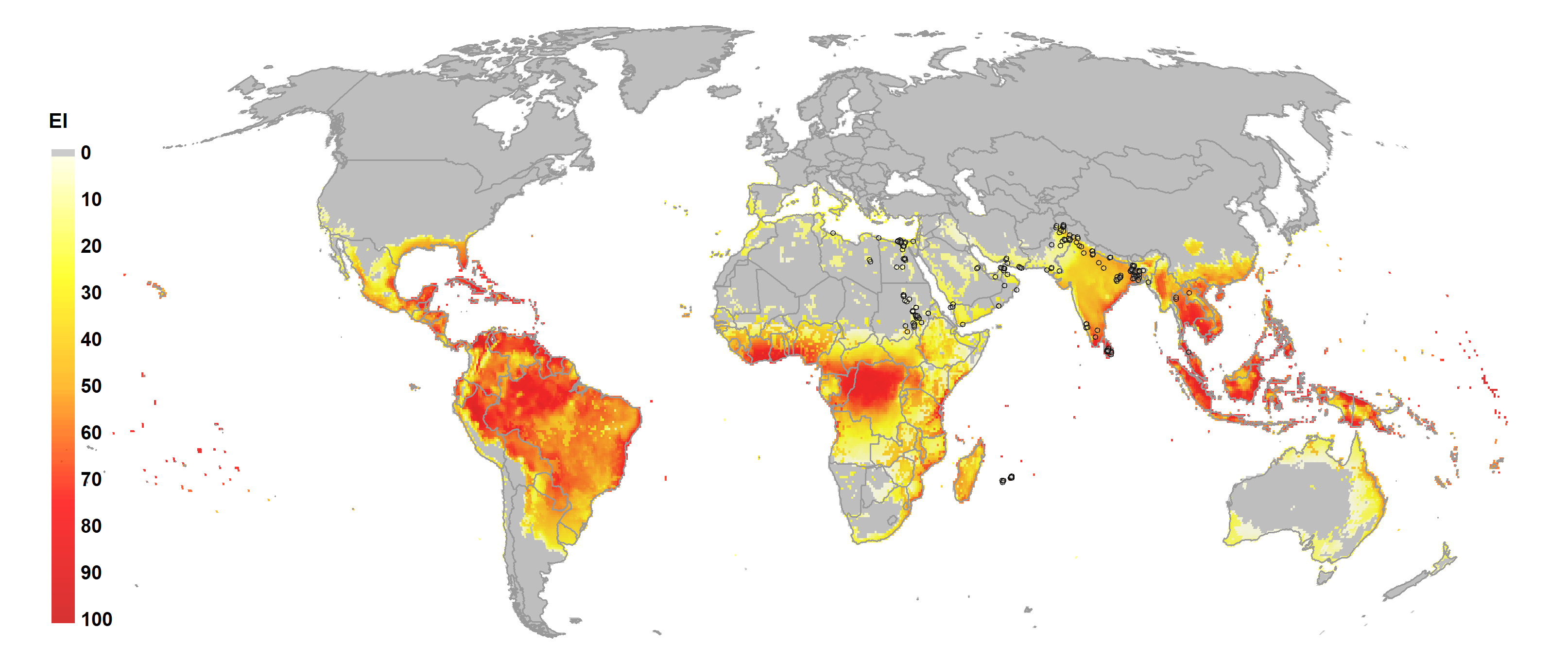DS-Alert System: Climate suitability maps
DS-Alert System: Climate suitability maps
Description
CLIMEX maps of climate suitability for three fruit fly species (Bactrocera dorsalis, Bactrocera zonata, and Ceratitis capitata). Maps cover the world or Europe.
Background
CLIMEX (Sutherst and Maywald, 1985; Kriticos et al., 2015) is a bioclimatic model used to model the climate suitability patterns for poikilotherms. The resulting model can be used to estimate the:
- potential distribution of the taxa,
- area where it can grow during favourable seasons,
- number of generations that it could complete at each location
The ability to estimate the potential distribution of the organism is central to the use of CLIMEX in pest risk analysis. CLIMEX is a hybrid inductive-deductive model. It can make use of species distribution data as well as thermal biology studies, theoretical expectations and phenological observations. As the model integrates information from these different knowledge domains, discrepancies highlight errors to be investigated. This has proven to be a robust form of model validation as the different domains are independent.
During the FF-IPM project it became clear that the climatology used for fitting bioclimatic models needed to be changed from 1961-1990 to 1981-2010 to take account of the climatic changes in that period.
In the maps below, the yellow-red areas are those where we expect that the organism could become established. The green shaded areas represent ephemeral habitat, where the organism could grow and complete one or more generations during favourable seasons but cannot persist year-round. In this zone, dispersal dynamics are important to the risk posed by the flies as they have to reinvade each year during the favourable season. Pest pressure is likely to be variable in this zone.
Ceratitis capitata
Ceratitis capitata (Medfly) is native to sub-Saharan Africa, and has been established in Europe for more than 100 years (Fimiani, 1989). During that period it expanded its range in Europe to fill its climatic niche. Consequently, C. capitata is not currently a border biosecurity concern for Europe. More recently, there is strong evidence that C. capitata has been expanding its range in Europe in response to climatic changes (Szyniszewska et al., 2024). In Europe, the boundary between the area that is suitable for C. capitata to overwinter (established area) and that where it can only grow its population during the warmer months (ephemeral habitat) has important implications for the management of C. capitata populations.

Global climate suitability patterns for Ceratitis capitata modelled using CLIMEX for the climate 1981-2010. The map is a composite of irrigation and natural rainfall scenarios based on the Global Map of Irrigated Areas (Siebert et al., 2013). ©Cervantes Agritech 2024.

Climate suitability patterns for Ceratitis capitata in Europe modelled using CLIMEX for the climate 1981-2010. The map is a composite of irrigation and natural rainfall scenarios based on the Global Map of Irrigated Areas (Siebert et al., 2013). ©Cervantes Agritech 2024.
Bactrocera dorsalis
The oriental fruit fly, Bactrocera dorsalis (Hendel, 1912), is a highly damaging pest of both fruits and vegetables, with a documented presence on 478 different hosts (USDA 2016). Originating from Asia, this species has proven to be a proficient biological invader, having established itself in over 65 countries, including much of Africa (CABI 2021). Concerns regarding invasions by B. dorsalis primarily revolve around the direct repercussions of infestations on fruit and vegetable production, as well as the impacts on market access and the need for additional phytosanitary measures.
A previously developed bioclimatic model of B. dorsalis (De Villiers et al. 2016) was revised to accommodate reports of its expanded range in China. We applied a more contemporaneous climatology to estimate the current global potential distribution of B. dorsalis. The recent detection of adult flies of B. dorsalis in France and Italy are in locations that appear climatically suited for B. dorsalis to establish.

Global climate suitability patterns for Bactrocera dorsalis modelled using CLIMEX for the climate 1981-2010. The map is a composite of irrigation and natural rainfall scenarios based on the Global Map of Irrigated Areas (Siebert et al., 2013). ©Cervantes Agritech 2024.

Climate suitability patterns for Bactrocera dorsalis in Europe modelled using CLIMEX for the climate 1981-2010. The map is a composite of irrigation and natural rainfall scenarios based on the Global Map of Irrigated Areas (Siebert et al., 2013). ©Cervantes Agritech 2024.
Bactrocera zonata
The peach fruit fly (B. zonata) is native to South and Southeast Asia. It is currently present in over 20 countries in Asia and Africa, including the Middle East. In Northern Israel, it is regularly detected in small numbers during favourable seasons. Bactrocera zonata poses an invasion threat to Europe. Once introduced to an area, it demonstrates remarkable adaptability to proliferate due to its polyphagous nature, high reproductive capacity, and natural dispersal abilities. During the FF-IPM project, the CLIMEX model of (Ni et al., 2011) was re-fitted according to information found in the literature in relation to fly response to environmental variables, as well as the most up-to-date occurrence data.

Global climate suitability patterns for Bactrocera zonata modelled using CLIMEX for the climate 1981-2010. The map is a composite of irrigation and natural rainfall scenarios based on the Global Map of Irrigated Areas (Siebert et al., 2013). ©Cervantes Agritech 2024.

Global climate suitability patterns for Bactrocera zonata modelled using CLIMEX for the climate 1981-2010. The map is a composite of irrigation and natural rainfall scenarios based on the Global Map of Irrigated Areas (Siebert et al., 2013). ©Cervantes Agritech 2024.
Pricing
These model outputs are provided free of charge. If you wish to reproduce them, please contact us here to discuss your needs.
If you are interested in us developing a CLIMEX model for another species for you, running climate change scenarios or developing different mapping products, please contact us here. For further information, please visit www.cervantesagritech.com.
Model limitations
The CLIMEX model mostly deals with climate suitability patterns, ignoring factors such as disturbance, host availability and suitability. The existence of favourable micro-habitats supporting the persistence of the species near the range edge may be included in the model implicitly through distribution records in areas that would otherwise be climatically unsuitable.
References
CABI (2021) Bactrocera dorsalis. Invasive Species Compendium. CAB International. www.cabi.org/isc, Wallingford, UK
De Villiers, M., Hattingh, V., Kriticos, D. J., Brunel, S., Vayssières, J.-F., Sinzogan, A., Billah, M. K., Mohamed, F. S., Mwatawala, M., Abdelgader, H., Salah, F. E. E. & De Meyer, M. (2016) The potential distribution of Bactrocera dorsalis: considering phenology and irrigation patterns. Bulletin of Entomological Research, 106, 19-33.
Fimiani P, 1989. Pest status; Mediterranean region. In: Robinson AS, Hooper G, eds. Fruit Flies; Their Biology, Natural Enemies and Control. World Crop Pests, 3(A):37-50. Amsterdam, Netherlands: Elsevier.
Kriticos, D. J., Maywald, G. F., Yonow, T., Zurcher, E. J., Herrmann, N. I. & Sutherst, R. W. (2015) CLIMEX Version 4: Exploring the Effects of Climate on Plants, Animals and Diseases. CSIRO, Canberra.
Ni, W. L., Li, Z. H., Chen, H. J., Wan, F. H., Qu, W. W., Zhang, Z. & Kriticos, D. J. (2011) Including climate change in pest risk assessment: the peach fruit fly, Bactrocera zonata (Diptera: Tephritidae). Bulletin of Entomological Research, FirstView, 1-11. doi:10.1017/S0007485311000538.
Siebert, S., Henrich, V., Frenken, K. & Burke, J. (2013) Update of the digital global map of irrigation areas to version 5. Rheinische Friedrich-Wilhelms-Universität, Bonn, Germany and Food and Agriculture Organization of the United Nations, Rome, Italy.
Sutherst, R. W. & Maywald, G. F. (1985) A computerised system for matching climates in ecology. Agriculture Ecosystems and Environment, 13, 281-299.
Szyniszewska, A. M., Bieszczak, H., Kozyra, K., Papadopoulos, N. T., De Meyer, M., Nowosad, J., Ota, N. & Kriticos, D. J. (2024) Evidence that recent climatic changes have expanded the potential geographical range of the Mediterranean fruit fly. Scientific Reports, 14, 2515.
USDA (2016) A Review of Recorded Host Plants of Oriental Fruit Fly, Bactrocera dorsalis (Hendel) (Diptera: Tephritidae). Version 2.1 A Product of the USDA Compendium of Fruit Fly Host Information (CoFFHI). A Farm Bill Project. APHIS PPQ
Zhao, Y., Duan, Y., Zhao, Z., Wang, Y., Wu, Q., Ding, J. & Li, Z. (2019) Study on overwintering of experimental population of Bactrocera dorsalis in Beijing. China Plant Protection, 39, 68-71.
Keywords
FF-IPM Developed, Tools, CLIMEX, Climate-suitability
Additional information
| Language | English |
|---|---|
| Person Responsible | Darren Kriticos, Anna Szyniszewska and Eleni Verykouki |
| Image(s) Ceratitis capitata (Medfly) | https://platform.fruitflies-ipm.eu/wp-content/uploads/2024/02/ei_cc_composite_map_robin_world.png, |
| Image(s) Bactrocera dorsalis | https://platform.fruitflies-ipm.eu/wp-content/uploads/2024/02/ei_bd_composite_map_robin_world.png, |
| Image(s) Bactrocera zonata | https://platform.fruitflies-ipm.eu/wp-content/uploads/2024/02/ei_bz_composite_map_robin_world.png, |
| Document(s) | https://platform.fruitflies-ipm.eu/wp-content/uploads/2024/02/Tool1.html |
Reviews
There are no reviews yet.